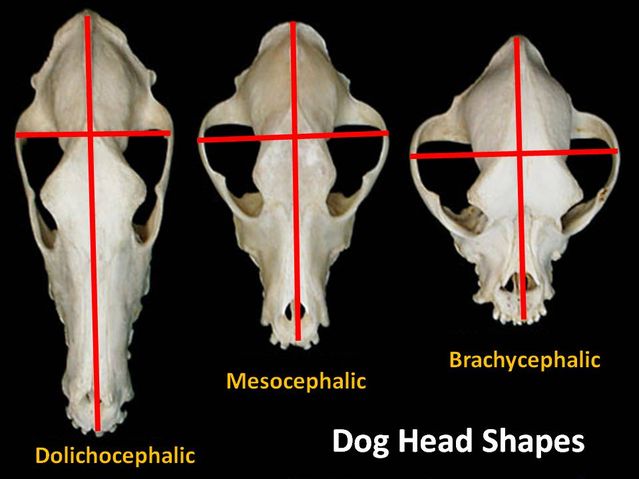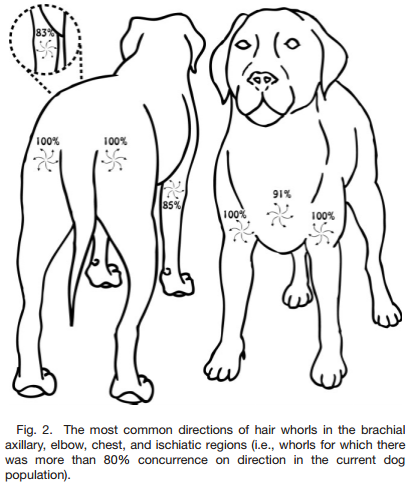Head Shape and Hair Whorls—Can They Influence Behavior?
In reading more about dog behavior for my project, characteristics such as head shape of dogs and how it can relate to behavior has made me think—are there other physical characteristics that we could look at to make inferences about an animal’s behavior?
Dr. Paul McGreevy a nd others have published articles on how skull characteristics may be related to behavior. In a recently published article, researchers looked at various physical characteristics, including head shape, and correlated them to a behavior assessment involving unfamiliar humans, different stimuli, and various objects. Almost 70,000 dogs were assessed over the course of seven years. From the data, they were able to make some generalizations about dog behavior. For example, they found that shorter dogs tended to show more aggression while taller dogs were usually more playful and friendly. Generalizations were made in this study relative to breeds and sizes of dogs. Additionally, although the authors used a structured instrument, assessment of behavior is always somewhat challenging, but the trends are very interesting.
nd others have published articles on how skull characteristics may be related to behavior. In a recently published article, researchers looked at various physical characteristics, including head shape, and correlated them to a behavior assessment involving unfamiliar humans, different stimuli, and various objects. Almost 70,000 dogs were assessed over the course of seven years. From the data, they were able to make some generalizations about dog behavior. For example, they found that shorter dogs tended to show more aggression while taller dogs were usually more playful and friendly. Generalizations were made in this study relative to breeds and sizes of dogs. Additionally, although the authors used a structured instrument, assessment of behavior is always somewhat challenging, but the trends are very interesting.
For the past 20 years, leading cattle welfare expert, Dr. Temple Grandin, has asserted that hair whorls may have some genetic basis relating to behavior of cattle. While similar studies on the genetic influence of hair whorls in humans have been published, it is disputed whether it is purely Mendelian inheritance or more complicated.
The research on hair whorls in various species has also translated to studies on dogs—from their anatomic basis to how they could be related to behavior. One study looked at the probability of a dog successfully becoming a Guide dog by looking at several factors, including hair whorls.
While these unique physical measures show some relation to behavior, they are observed as part of a more comprehensive behavioral assessment. Looking at these characteristics alone should be observed with caution. Generalizations are challenging because of the extreme differences across dog breeds, even when researchers try to take these variations into account.

In a previous article from 2012, “Breeding dogs for beauty and behaviour: Why scientists need to do more to develop valid and reliable behaviour assessments for dogs kept as companions”, the authors remind us that ‘Many dogs exhibit behaviours their owners consider undesirable and these dogs may cause disruption and injury to humans and other animals. As a consequence, many are relinquished to shelters.’ They go on to suggest that owner-dog (or we might say owner-breed) mismatch may contribute to the problem, especially if the owner’s interest is more on the appearance of the dog than other factors. ‘The measurement of behaviour and limitations of existing canine behaviour assessments are discussed’ in the article and the authors stress that more accurate assessments are needed. They also stress that behavior, as well as the changing roles of dogs, must be considered in the wider context of dog breeding.
So, just to keep you thinking about the complex issues in ethics and welfare of breeding dogs, I wonder:
- Are there other characteristics beyond these that we should be considering when thinking about dog behavior?
- How is this incorporated into breeding healthy, happy dogs?
- Are veterinary students being well-prepared for all these issues?
For up-to-date information on project my developments, see A Veterinarian's Role in the Ethics and Welfare of Breeding Dogs.
In addition, please check out my first learning module: Introduction to the Module: What is Your Role in Addressing Inherited Disease in Purebred Dogs? ... and ...
Stayed tuned for my next educational module looking at Supply and Demand of dogs which will highlight what we know and don’t know about how people choose their dogs and where those dogs come from.
Skull Shape image credit: https://cdn.psychologytoday.com/sites/default/files/styles/image-article_inline_full/public/field_blog_entry_images/Dog head shapes.jpg?itok=edD7ujTW
Whorl photo credit: http://4.bp.blogspot.com/-hGoXIo019ic/UOUF0j8MhQI/AAAAAAAABTQ/_V-JO5GXntY/s1600/Whorls2.png
 Donate
Donate
0 Comments
Recommended Comments
There are no comments to display.